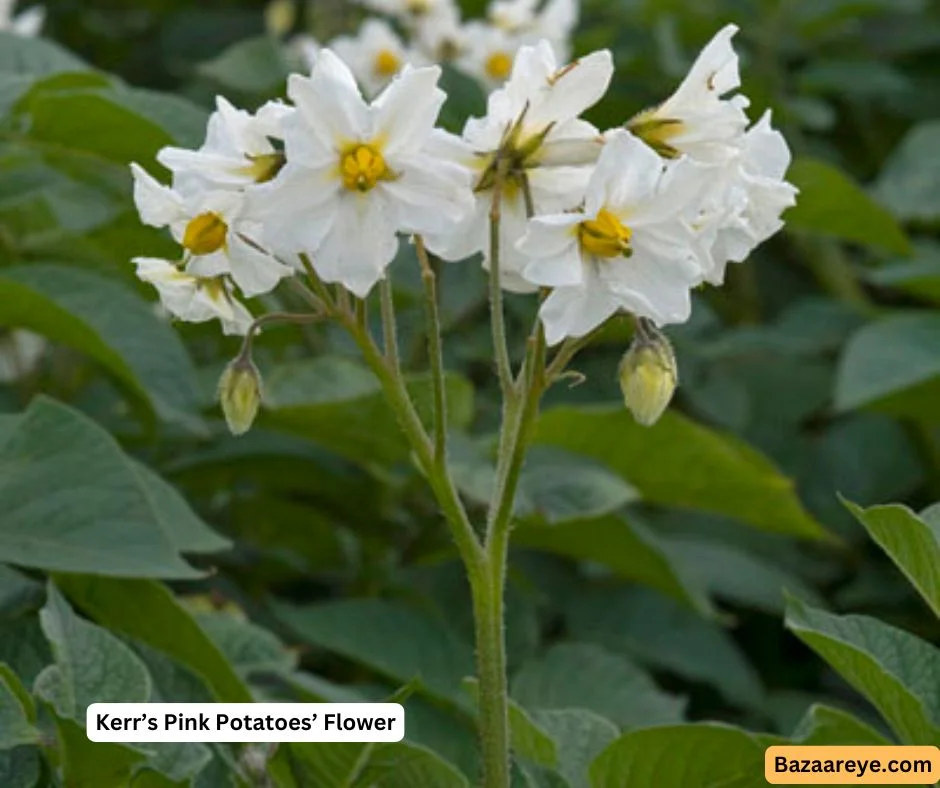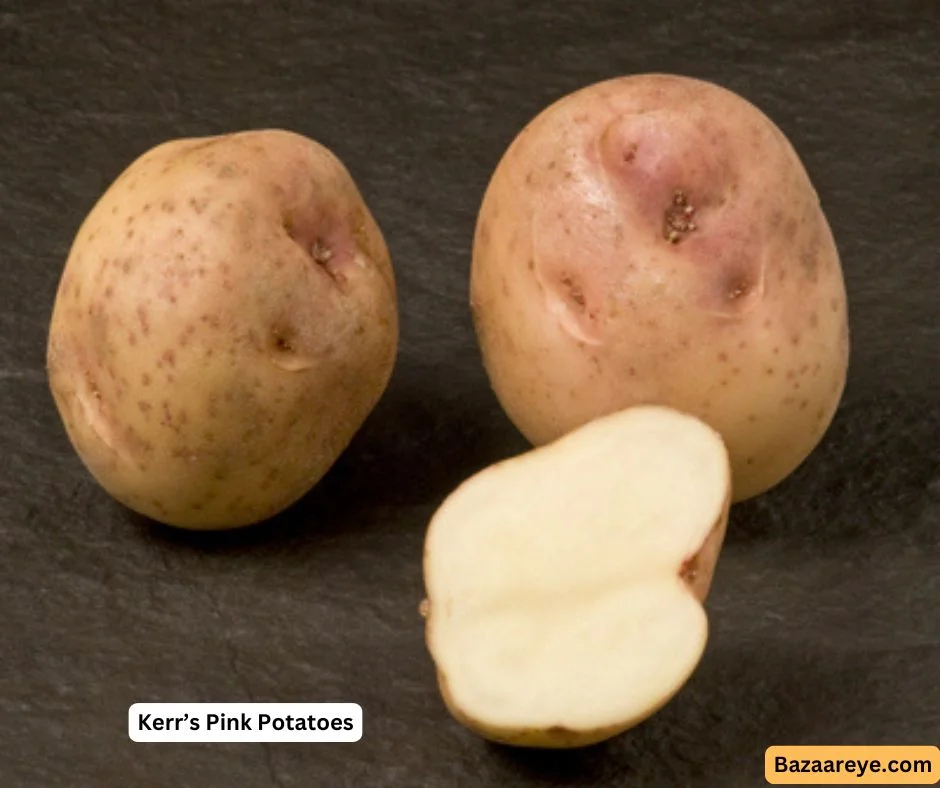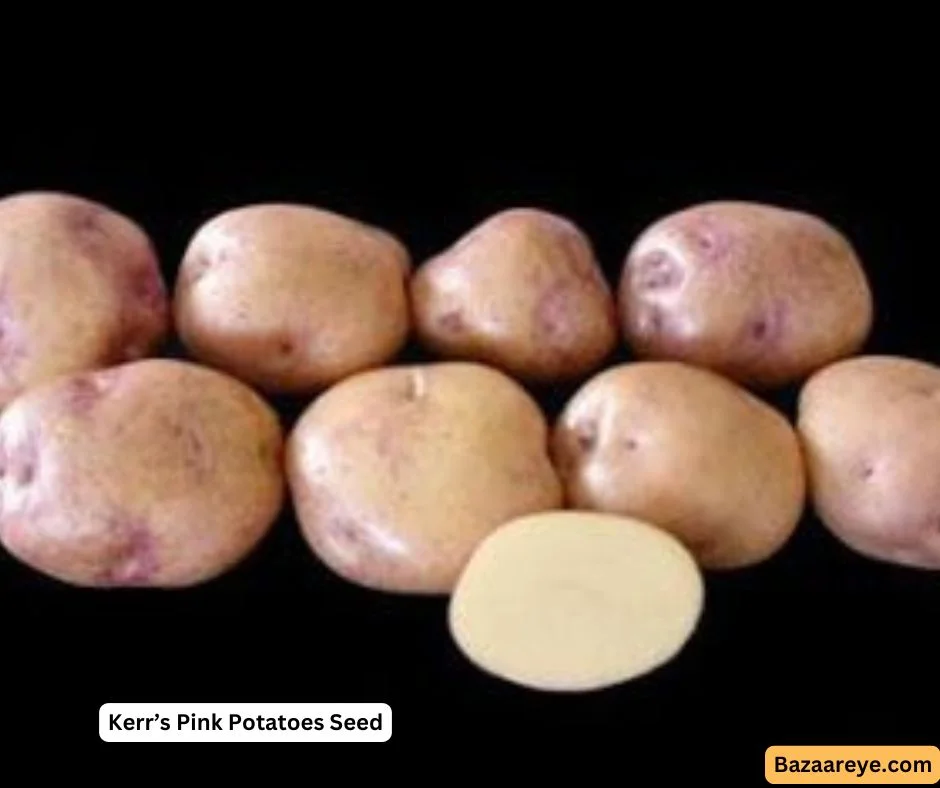If you’re a potato enthusiast or a gardener looking to grow a unique, heritage potato variety, Kerr’s Pink potatoes are an excellent choice. Known for their distinctive flavor and soft, floury texture, these potatoes have a lot to offer. This guide covers all you need to know about Kerr’s Pink potatoes, from their plant characteristics to tips for successful growth and harvest.
Overview of Kerr’s Pink Potatoes
Originating in Scotland in 1907, Kerr’s Pink potatoes are popular in Ireland and parts of the UK due to their excellent flavor, especially suited to mashing and boiling. Their pink-tinged skin and white flesh set them apart visually, making them a delightful addition to any home garden or farmer’s market stand.
What do you need to do to grow Cromwell Potatoes?
Plant Characteristics of Kerr’s Pink Potatoes
Understanding the growth patterns and needs of Kerr’s Pink potatoes is essential for maximizing their yield and quality. Here’s a breakdown of their plant characteristics:
- Maturity:
- Growth Time: Very late to late maturity
- Notes: Kerr’s Pink potatoes take longer to mature than most varieties, making them ideal for gardeners who plan for a late-season harvest. Their growth extends well into the fall, with tubers developing a rich flavor over time.
- Growth Habit:
- Structure: Semi-erect to erect
- Notes: The semi-erect to erect growth habit makes Kerr’s Pink plants relatively sturdy, though they may still need some space to spread. Spacing them well will allow for maximum sun exposure and airflow, crucial for healthy growth.
- Foliage Cover:
- Coverage: Ranges from poor to moderate to good
- Notes: Kerr’s Pink potatoes can have variable foliage coverage. In some conditions, it may be sparse, which makes weed management important. When foliage is dense, it provides some ground cover that helps retain soil moisture.
- Flower Color and Frequency:
- Color: White
- Frequency: Rare to frequent flowering
- Notes: This variety displays white flowers, adding visual interest to the garden. Flowering frequency can vary, from rare to frequent, depending on growing conditions, but flowering has minimal effect on the yield.
- Berry Production:
- Presence: Very rare to no berries
- Notes: Kerr’s Pink potatoes seldom produce berries, so don’t be surprised if they don’t appear on your plants. The absence of berries does not impact the health or productivity of the plant.
- Light Sprout Color:
- Color: Pink
- Notes: During storage or pre-planting sprouting, Kerr’s Pink tubers produce distinctive pink-colored sprouts, a signature trait of this variety. This unique color makes them easy to identify during the chitting (pre-sprouting) process.

Growing Tips for Kerr’s Pink Potatoes
Growing Kerr’s Pink potatoes can be rewarding if the right conditions are met. Here are some tips to ensure a successful harvest:
Tip: Let the tubers sit in the soil for a week or two after the foliage dies to allow the skins to toughen, which helps them store longer.
Soil Preparation
- Type: Loamy, well-draining soil
- Amendments: Add compost or well-rotted manure before planting
- pH Level: 5.0–6.0 for optimal growth
- Tip: Ensure the soil is loose enough for the tubers to expand fully. A high-nutrient, organic-rich environment will support the slow-growing nature of Kerr’s Pink potatoes.
Planting and Spacing
- Depth: Plant 10–15 cm deep
- Spacing: Space plants 30–40 cm apart in rows 60–75 cm apart
- Tip: This spacing ensures adequate airflow and sunlight, which are critical for plants with variable foliage cover.
Watering
- Frequency: Regular, consistent watering
- Method: Water deeply at the base of the plant
- Tip: Kerr’s Pink potatoes need consistent moisture but should not be waterlogged. Regular, deep watering supports tuber formation, especially in drier conditions.
Fertilizing
- Type: Balanced, slow-release fertilizer
- Schedule: Apply at planting and midway through the growing season
- Tip: Avoid over-fertilizing with nitrogen, as this can result in excessive foliage with fewer tubers.
Pest and Disease Management
- Common Issues: Late blight, aphids, and potato beetles
- Preventive Measures: Use organic fungicides, practice crop rotation, and ensure good garden hygiene
- Tip: Kerr’s Pink potatoes can be susceptible to blight, so monitoring and early intervention are critical. Ensure adequate spacing and avoid overhead watering to prevent the spread of disease.
Harvesting
- Timing: Late season, typically 90–120 days after planting
- Signs: Foliage will start to yellow and die back
Check how Nicola Potatoes are different fro other varieties.
Tuber Characteristics of Kerr’s Pink Potatoes
Skin and Eye Color
Kerr’s Pink Potatoes are known for their eye-catching red skin, which gives them a distinct look in the garden and at the market. The tuber eyes, also red, blend subtly with the skin, maintaining a consistent appearance across the surface. This vibrant red color can be a draw for those looking to grow visually appealing potatoes.
Flesh Color
The flesh of Kerr’s Pink potatoes ranges from white to light yellow, offering a creamy and appealing appearance when cooked. This subtle color variance adds to its appeal in the kitchen, making it a versatile choice for various potato dishes.

Tuber Shape and Eye Depth
The tubers of Kerr’s Pink potatoes are generally round, which simplifies the peeling process and makes them ideal for uniform slicing and dicing. The eyes of the tubers range from deep to medium depth, which can add a bit of work during preparation, but also contributes to the character of this heritage variety.
Skin Texture
Kerr’s Pink potatoes feature a skin texture that is smooth to intermediate, allowing for easier cleaning and handling. The skin’s relatively smooth surface also helps retain the tuber’s moisture and protect it from minor abrasions, extending its storage life post-harvest.
Tubering Characteristics of Kerr’s Pink Potatoes
Yield Potential and Tubers per Plant
Kerr’s Pink potatoes offer a medium to high yield potential, making them a rewarding choice for growers looking for a productive crop. The number of tubers per plant ranges from medium to many, depending on the growing conditions. This high tuber count can provide a bountiful harvest, especially in well-maintained soil.
Tuber Size and Shape Uniformity
The size of Kerr’s Pink potatoes tends to be medium to large, with many tubers reaching a substantial size ideal for a variety of culinary uses. However, tuber shape uniformity is variable to medium, which means you may find some irregular shapes in your harvest. This trait gives Kerr’s Pink Potatoes a rustic, homegrown appeal while still being practical for most kitchen needs.
Secondary Growth and Internal Quality
This variety is prone to high levels of secondary growth, which can result in knobby or irregularly shaped tubers, especially if the growing conditions fluctuate. Additionally, Kerr’s Pink potatoes have a medium tendency for internal rust spots, which may affect some tubers but is generally not significant enough to impact the entire crop.
Dormancy Period
Kerr’s Pink potatoes have a medium dormancy period, which makes them suitable for longer storage compared to early-season varieties. This dormancy period provides flexibility, allowing the tubers to be stored for weeks after harvest without rapid sprouting, making them an excellent option for winter storage.
What do you need to succeed in the cultivation of Osprey Potatoes?
Utilization Characteristics of Kerr’s Pink Potatoes
Cooking Type and Texture
Kerr’s Pink potatoes are highly versatile in the kitchen, with a cooking type that ranges from mealy to fairly firm. This flexibility makes them suitable for various recipes, from fluffy mashed potatoes to boiled or roasted dishes. Their texture holds up well in different preparations, providing a mealy quality ideal for mash while still working as a multi-purpose type for other cooking methods.
After Cooking Blackening and Enzymic Browning
Kerr’s Pink potatoes experience minimal to no after-cooking blackening, which means they retain their color well once prepared, enhancing their visual appeal in dishes. Enzymic browning is also trace, so cut pieces can be prepped in advance without significant discoloration, adding to their convenience for both home cooks and chefs.
Taste
This variety is known for its good taste, making it a popular choice for those seeking rich, earthy flavors in their dishes. The natural flavor profile of Kerr’s Pink potatoes shines through in simple preparations, requiring little seasoning to bring out its best qualities.

Crisp and French Fry Suitability
Kerr’s Pink potatoes have excellent suitability for both crisps and French fries, making them ideal for frying. Their texture and flavor develop well in high heat, resulting in a crispy exterior and a light, tender interior, making them a favorite for fried potato snacks and sides.
Dry Matter and Starch Content
With a high dry matter content, Kerr’s Pink potatoes have a desirable texture for frying and mashing, as this contributes to their fluffiness and ability to hold shape. The medium starch content provides enough structure without making them overly dense, giving them a well-balanced consistency for various culinary uses.
Resistance to Fungal Diseases in Kerr’s Pink Potatoes
Resistance to Late Blight
Kerr’s Pink potatoes exhibit low resistance to late blight on tubers and medium to low resistance on foliage, which poses a challenge for growers in regions with high blight pressure. Laboratory tests confirm low resistance levels for both tubers and foliage and field trials with artificial inoculum also show low to medium resistance in foliage. Therefore, proactive management, including proper spacing, adequate airflow, and preventive fungicide applications, is essential to mitigate blight risk.
Resistance to Wart Disease (Synchytrium endobioticum)
One of Kerr’s Pink Potatoes’ strong points is their field immunity to wart disease, with complete immunity to both Race 1 and Race 2 wart strains. This field immunity makes them a reliable choice for areas where wart disease is a concern, providing peace of mind and potentially reducing the need for wart management measures.
Resistance to Gangrene (Phoma foveata) and Dry Rot (Fusarium spp.)
Kerr’s Pink potatoes have medium resistance to both gangrene and dry rot, which helps to minimize post-harvest losses during storage. While this medium resistance level isn’t a complete safeguard, it allows for a relatively longer storage period with fewer losses, especially when proper storage conditions—cool, dark, and well-ventilated spaces—are maintained.
Flavor Queen, British Queen potatoes for your garden
Resistance to Bacterial Diseases in Kerr’s Pink Potatoes
Resistance to Common Scab (Streptomyces scabies)
Kerr’s Pink potatoes show low resistance to common scab, making them somewhat susceptible to this bacterial disease, which can cause rough, unsightly patches on the tubers. This can be a consideration for growers aiming for visually appealing produce. To manage scab, it’s beneficial to maintain slightly acidic soil conditions and avoid over-fertilization with nitrogen.
Resistance to Blackleg (Erwinia spp.)
Kerr’s Pink potatoes have a medium resistance to blackleg, which offers moderate protection against this bacterial disease affecting stems and tubers. Although this level of resistance helps limit the risk, good field hygiene practices and proper crop rotation are recommended to keep blackleg incidence low.

Resistance to Bacterial Soft Rot (Erwinia spp.)
With medium to high resistance to bacterial soft rot, Kerr’s Pink potatoes are relatively robust against this decay-causing disease, especially in storage or during wet growing conditions. This resistance level makes them less prone to rot, contributing to better post-harvest quality and shelf life, especially when stored in dry, well-ventilated conditions.
Resistance to Virus Diseases in Kerr’s Pink Potatoes
Resistance to Potato Virus A
Kerr’s Pink potatoes exhibit very high resistance to potato virus A, offering strong protection against this virus, which can cause leaf mottling and stunted growth. This high resistance level provides an advantage for growers, as it reduces the need for specific management practices against this virus.
Resistance to Potato Virus X and Potato Virus Y
The resistance to potato virus X is low, meaning Kerr’s Pink potatoes are vulnerable to this virus, which can lead to mottling and yield reduction. Resistance to potato virus Y varies from low to medium, depending on environmental factors. Potato virus Y can cause mosaic symptoms and affect tuber development, so growers should take precautions, such as managing aphids that can spread the virus.
Resistance to Potato Leaf Roll Virus
Kerr’s Pink potatoes have a low to medium resistance to potato leaf roll virus, which causes leaf curling and can reduce tuber quality. This moderate susceptibility requires monitoring and management, especially in areas where leaf roll virus is prevalent.
Resistance to Tobacco Rattle Virus
Resistance to tobacco rattle virus is also low to medium, making Kerr’s Pink potatoes moderately susceptible. This virus can cause spindly tuber growth and reduce overall yield, so using virus-free seed potatoes and practicing crop rotation can help reduce infection risk.
Resistance to Pests in Kerr’s Pink Potatoes
Resistance to Globodera rostochiensis (Potato Cyst Nematode) Race 1
Kerr’s Pink potatoes have low resistance to Globodera rostochiensis race 1, a type of potato cyst nematode that can cause significant root damage, reducing plant health and tuber yield. Due to this low resistance, growers need to implement preventive measures, such as crop rotation with non-host plants and using nematode-resistant cover crops, to help minimize the impact of this pest in affected areas.
Master the art of growing Golder Wonder Potatoes
Environmental Stress Factors for Kerr’s Pink Potatoes
Drought Resistance
Kerr’s Pink potatoes have medium resistance to drought, meaning they can tolerate moderately dry conditions but will perform best with consistent moisture. During prolonged dry spells, regular watering is essential to support tuber development and maintain plant health. To optimize drought resistance, applying mulch can help retain soil moisture, and proper soil preparation with organic matter can improve water-holding capacity, aiding growth during drier periods.
Conclusion
Kerr’s Pink potatoes are a unique, heritage variety that stands out for its red skin, mealy texture, and versatile culinary uses. While they require a bit more care to manage susceptibility to blight, viruses, and certain pests, their high yield potential, good taste, and adaptability in the kitchen make them worth the effort. With a medium dormancy period, moderate drought resistance, and strong storage potential, they’re a great choice for home growers looking to enjoy fresh potatoes well into the colder months.
How to Cook Kerr’s Pink Potatoes?
Kerr’s Pink potatoes are excellent for mashing, baking, or frying. Their mealy texture makes them ideal for creamy mashed potatoes or crispy fries. For the best results, cook them with minimal seasoning to highlight their natural flavor.
When to Plant Kerr’s Pink Potatoes?
Plant Kerr’s Pink potatoes in early to mid-spring once the risk of frost has passed. This variety is slow-maturing, so starting them early gives them the full season to grow.
When to Harvest Kerr’s Pink Potatoes in the UK
In the UK, Kerr’s Pink potatoes are typically harvested in late autumn. Look for the foliage to start yellowing and dying back as a sign that the tubers are ready. Harvest usually occurs 90–120 days after planting, depending on growing conditions.
3 thoughts on “Kerr’s Pink Potatoes: A Heritage Variety for Flavorful Harvests”